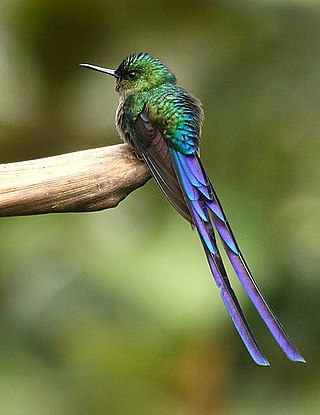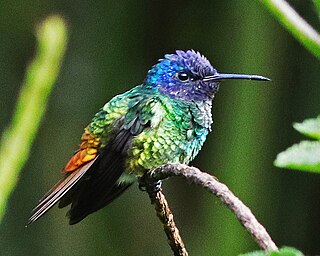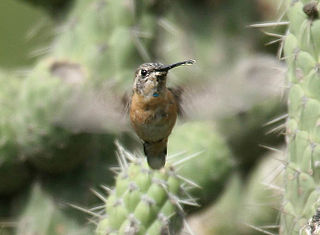
The violet sabrewing is a species of hummingbird in the "emeralds", tribe Trochilini of the subfamily Trochilinae. It is found from Mexico to Panama.

The purple-throated mountaingem is a species of hummingbird in tribe Lampornithini of subfamily Trochilinae. It is found in Costa Rica, Nicaragua, and Panama.

The green-crowned brilliant is species of hummingbird in the "brilliants", tribe Heliantheini in subfamily Lesbiinae. It is found in Colombia, Costa Rica, Ecuador, and Panama. It is also known as the green-fronted brilliant.

The violet-tailed sylph is a species of hummingbird in the "coquettes", tribe Lesbiini of subfamily Lesbiinae. It is found in Colombia and Ecuador.

The sapphire-spangled emerald is a species of hummingbird in the "emeralds", tribe Trochilini of subfamily Trochilinae. It is regularly found in Bolivia, Brazil, Peru, and Venezuela; as a vagrant in Argentina; and has possibly occurred in Ecuador.

The long-tailed sylph is a species of hummingbird in the "coquettes", tribe Lesbiini of subfamily Lesbiinae. It is found in Bolivia, Colombia, Ecuador, Peru, and Venezuela.

The hooded visorbearer is a small species of hummingbird in the family Trochilidae. Endemic to the east Brazilian state of Bahia, it is found only at higher altitudes in the Chapada Diamantina region. The species is sexually dimorphic. The male is an iridescent bronzy-green overall, with black on his crown and the sides of his head. His forehead and throat are a glittering green shading to bluish-green at the lower edge and narrowly bordered by black. The female is bronzer, with a green crown and brown sides to her head. Her throat is less colorful than the male's, and she lacks iridescence on her forehead. Both sexes have crimson tails and a narrow white breast band, the male with a brilliantly iridescent golden-orange spot in the center, at the lower edge of his gorget.

The golden-tailed sapphire is a species of hummingbird in the family Trochilidae. It is found in Bolivia, Brazil, Colombia, Ecuador, Peru, and Venezuela.

The rainbow starfrontlet is a species of hummingbird in the "brilliants", tribe Heliantheini in subfamily Lesbiinae. It is found in Ecuador and Peru.

The violet-throated starfrontlet is a species of hummingbird in the "brilliants", tribe Heliantheini in subfamily Lesbiinae. It is found in Bolivia and Peru and possibly Ecuador.

The amethyst-throated sunangel is a species of hummingbird in the "coquettes", tribe Lesbiini of subfamily Lesbiinae. It is found in Bolivia, Ecuador, and Peru.

The royal sunangel is an endangered species of hummingbird in the "coquettes", tribe Lesbiini of subfamily Lesbiinae. It is found in Ecuador and Peru.

The violet-fronted brilliant is a species of hummingbird in the "brilliants", tribe Heliantheini in subfamily Lesbiinae. It is found Bolivia, Colombia, Ecuador, Peru, and Venezuela.

The velvet-browed brilliant is a species of hummingbird in the "brilliants", tribe Heliantheini in subfamily Lesbiinae. It is found in Brazil, Guyana, Suriname, and Venezuela.

The sapphire-throated hummingbird is a shiny metallic-green hummingbird found in Panama, Colombia, and more recently Costa Rica. The sapphire-throated hummingbird is separated into three subspecies; Chrysuronia coeruleogularis coeruleogularis, Chrysuronia coeruleogularis coelina, and Chrysuronia coeruleogularis conifis.

The purple-collared woodstar is a species of hummingbird in tribe Mellisugini of subfamily Trochilinae, the "bee hummingbirds". It is found in Ecuador and Peru.

Geoffroy's daggerbill, Geoffroy's wedgebill, or eastern wedge-billed hummingbird is a species of hummingbird in the family Trochilidae. It is found in Bolivia, Colombia, Ecuador, Peru, and Venezuela.

The fork-tailed woodnymph is a species of hummingbird in the "emeralds", tribe Trochilini of subfamily Trochilinae. It is found in every mainland South American country except Chile and Uruguay.

The curve-winged sabrewing is a species of hummingbird in the "emeralds", tribe Trochilini of subfamily Trochilinae. It is endemic to Mexico.

The crowned woodnymph or violet-crowned woodnymph is a species of hummingbird in the "emeralds", tribe Trochilini of subfamily Trochilinae. It is found from Belize and Guatemala to northern Peru.























